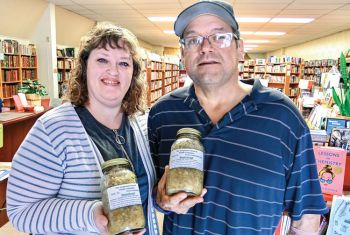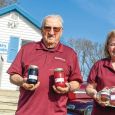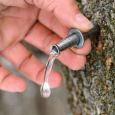The Gift of South Dakota
Subscriptions to South Dakota Magazine make great gifts!
Subscribe today — 1 year (6 issues) is just $29!
Saved by Sauerkraut
Wade Jorgenson was a longtime kraut lover, but he never attempted to make it until Larry Betlach of Brookings offered to show him in 2007. “Larry was tired of me for asking him for his sauerkraut, so he taught me how to make it myself,” Wade laughs.
Jorgenson, who lives in Hayti, also remembers when Betlach came back six weeks later to check the sauerkraut’s progress. “He skimmed the gunk off the top and just took a bite from the pail. I about dropped over dead seeing that. But he said, ‘Hey, that’s good kraut!’”
On that day, Jorgenson never could have guessed the role that sauerkraut would play in his life. A few years later, his wife Tiffany began to sell patch quilts at craft fairs for some extra money. She didn’t have much luck. Then a lady came by her booth and asked why she didn’t try selling her husband’s sauerkraut.
Tiffany brought along some jars at the next craft show and sold them all. The Jorgenson Kraut and Pickle Company was born.
Unfortunately, a new challenge came just as they were starting to find success. Diabetes runs in the Jorgenson family, and Wade inherited the gene. Diagnosed with renal disease, he was placed on a kidney transplant list five years ago.
He was surviving on kidney dialysis, but the treatments and the disease sapped his time and energy. Soon he was unable to work, so the Jorgensons became a one income family. Luckily, sauerkraut sales paid the bills. Even more importantly, says Tiffany, the business gave Wade purpose through those hard years.
“We thought he could eventually get back to work, but his health got worse,” Tiffany says. “Making sauerkraut gave him freedom. We have no deadlines, and we just sell what we can make so there is less pressure. Plus Wade is passionate about it. He wants everyone to love sauerkraut.” Now they process about 2,500 pounds of cabbage a year and can’t keep up with the demand.
Despite the volume, Wade is as excited as ever about sharing kraut — both by the jar and in conversation. He says while there are basic rules for making sauerkraut, it is an art. “You have to go through the steps but then you have to have faith.”
The rules are simple. After shredding the cabbage, it’s a common safety measure to add 3 tablespoons of salt for every 5 pounds of cabbage. If you want to add seasoning, mix it at the same time as the salt. Then “smash” or “massage” the cabbage and it will naturally release water, which turns to brine. Next, fill your fermentation containers, which can range from wide mouth canning jars to 5-gallon buckets. Wade covers his containers with plates and then weighs them down with bowling balls. The weight is there to keep the cabbage under the brine. Next, cover the container to keep out the air, allowing it to ferment.
“Then it’s safe,” he says. “I’ve never had a problem with anything bothering it after it starts fermenting. Everything is afraid of it.”
Be sure the sauerkraut is stored in a controlled environment. It typically takes six to eight weeks to ferment. “We keep it at 70 degrees or so. Then I taste it to know when it’s ready. It’s a leap of faith to eat something that’s rotting in your basement,” he jokes.
As for the layer of “gunk” that collects on top of the kraut, Wade says that’s normal. Betlach’s dad passed on a secret remedy for the gunk-averse. “Once everything is ready to ferment, put full clean cabbage leaves on top and then the weights over it. Then the leaves, not the kraut, will be what spoils.”
Wade experimented for two years before developing the recipe he now sells. He won’t share it entirely, but he does acknowledge that he uses dill weed, dill seed and caraway. Developing your own recipe is part of the fun, he says. “We just make one recipe to sell. But it’s fun to try new things. Add jalapeno or garlic. Maybe juniper berries.”
Food-making comes naturally to Wade. He worked as a cook through college at South Dakota State University, and before that he whipped up roasted chicken and steaks as a high schooler at his parents’ Pheasant Lanes in Hayti.
Wade and Tiffany, both Hayti natives, were married in 2010. Their son, Jeter, a fourth grader, helps with the production but his specialty is marketing. “He’s such a good little salesman and loves talking to customers about sauerkraut,” says Tiffany.
After five years of waiting on a transplant list, Jorgenson was notified by the University of Minnesota Medical Center that an anonymous live donor is giving a kidney. It’s something the Jorgensons thought would never happen. Even while waiting for the transplant, Wade was already thinking about next year’s sauerkraut production. “With a new kidney I think we can make twice what we did this summer,” he said.
“He has big plans,” laughs Tiffany. “He’s a dreamer for sure.”
Editor’s Note: This story is revised from the September/October 2023 issue of South Dakota Magazine. To order a copy or to subscribe, call (800) 456-5117.











Comments